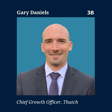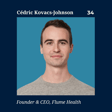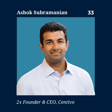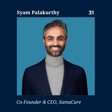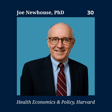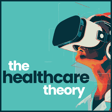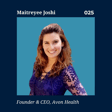Introduction to the Healthcare Theory Podcast
00:00:00
Speaker
Welcome to the Healthcare Theory Podcast. I'm your host, Nikhil Reddy, and every week we interview the entrepreneurs and thought leaders behind the future of healthcare care to see what's gone wrong with our system and how we can fix it.
Meet Abhishek Mohanty and CareFlick
00:00:14
Speaker
Today we're speaking with Abhishek Mohanty, the founder of CareFlick, a startup using AI to address loneliness and isolation for seniors. So hi Abhishek, thank you so much for coming on today. Super excited to have you.
00:00:25
Speaker
Hey Nikhil, thank you for having me. um Yeah, super excited to be here. Of course. And before we get into Careflake and all the exciting work that you guys are doing, can you kind of walk me through your background? Like what even brought you to health care in the first place?
00:00:38
Speaker
ah Well, I think it was more accidental. oh I did not have any background in the health care space. ah and straight out of college, I started a design firm where i convinced bunch of my college friends to quit their job and start working with me. And we landed few projects like design projects, graphic design projects with companies like Maruti Suzuki International.
00:01:00
Speaker
And after that, I went on to start a D2C brand in the Indian handicraft and handling space. And we were, you know, we were doing a quirky products out of old age art forms. Like for example, if you would have heard of traditional silk from Bihar, which is called Bagalpur silk, we used to make DSLR camera straps and guitar straps out of them so that it would appeal to the new generation.
Journey into Healthcare: From Design to Acquisition
00:01:26
Speaker
So that's what I was mostly doing when the founder of Epoch Eldercare, a senior living startup based out of India, she reached out to me and then she wanted some help with design and marketing.
00:01:38
Speaker
And initially I started off as a, it started off as a consulting gig But I love that space. um I love working with seniors and I love the work EPOC, the people at EPOC were doing in taking care of seniors.
00:01:54
Speaker
And I started, you know, increasing my involvement with them. And I went on to become like part of the leadership team, leading design and marketing, helping them set up multiple assisted living and dementia care homes across India.
00:02:10
Speaker
And while I was part of the leadership team, we got acquired by ah ah by a PE firm called lu Loomis Partners. And that's how I kind of spent like seven years in that space.
00:02:22
Speaker
And I got hooked into that space, especially like the senior care industry. So that's how my journey started in the healthcare care space.
Personal Motivation and Senior Care Insights
00:02:31
Speaker
Awesome. And like, what do you like working about with seniors? Because of course, like, I think more people are ah often like gravitated towards kids because they have that youthfulness in them. But seniors often face like similar problems like isolation and things like that. But mean, what made you so passionate about working in that space and alleviating like their concerns and problems?
00:02:50
Speaker
I've never really thought about it in depth, but I feel that it's more like a personal journey. ah my My mom passed away like about 12 years ago. And since then, it's just been my dad by himself.
00:03:03
Speaker
I'm the only child. And I kind of seen him, you know, retire and age and, you know, ah try to find purpose and, you know, how he was living his life. And that kind of got me thinking that,
00:03:16
Speaker
one, I would kind of want to work in this space that actually helps more seniors like him. And yeah, I think that's my personal connection with the senior care industry. That's really great. um I think that it's just ah it's it's hard. It's course, when we're younger, it's harder to have empathy for them. But it's like, of course, like a super, it's a lot of important issues and a huge amount of people facing them. So i mean, what kind of problem did you identify before starting Care Flake? What did you, I know kind of hinted towards it, but what was the problem that you ended up trying to solve?
00:03:46
Speaker
oh So, like I said, it all connects back to my dad. You know, as a kid, I would always think my dad is is the superhero, right? And it it becomes very difficult to accept the fact that he's aging.
00:04:00
Speaker
And while he has been always supporting me throughout his life, ah it's difficult to accept the fact that it's time now that he needs my support, right? Now he's...
00:04:12
Speaker
ah He's in that stage where you know you would feel more vulnerable by yourself. So those were kind of my triggers to kind of think that how do I kind of help him?
00:04:23
Speaker
And yeah, that's that's what I feel kind of motivated me to enter this space. Awesome. And can you ah can you kind of walk us through like what your solution is? How did you come up with this
CareFlick's Evolution and Yana's Creation
00:04:34
Speaker
idea around Careflake? Because it's really innovative using AI to address senior care through like a digital companion. That's super exciting and I think probably one of the first people to do that. So we'd love to hear your your idea. How did you come up with this? and Can you walk the audience through like what it even does?
00:04:49
Speaker
Oh, that was actually not the first problem that we were trying to solve. Oh, wow. Initially, we thought of it like creating a care and team management platform for informal caregivers, like family members, people who are struggling to manage care at home for their seniors. so And that product within itself had co-pilot for caregiving. um You know, and we called her YANA.
00:05:11
Speaker
It stands for You Are Not Alone. And very recently, I made like a trip to the Bay Area ah last year. And I met someone from the NVIDIA team. And that gentleman introduced me to NVIDIA Ace and how you can give Yana face.
00:05:28
Speaker
And while we were, you know, like understanding our product, trying to find product market fit, we we landed upon this deep-rooted problem in senior care where everyone is trying to solve for engagement of seniors because...
00:05:42
Speaker
as you age, you might your your social circle would have shrunk. You would have moved away from your friends. And you know that leads to loneliness and social isolation. And we thought that why not give Yana a face and make her like a companion for seniors who's able to understand ah the seniors at a personalized level and able to do intellectual companionship, do digital activities, help them lead a more healthy lifestyle.
00:06:10
Speaker
through proactive reminders and so on so forth and so forth. It's been a journey how we landed upon Yana, starting from a care and team management platform, which is like a SaaS platform, to creating like you know a true AI companion that engages with seniors with empathy.
00:06:27
Speaker
Yeah, it's really interesting. It's good that you guys are able save some mobile and like kind of navigate your solution
Cultural Adaptation of Yana
00:06:31
Speaker
through that. But but when you're designing Yana, you could have done... like Male, female, I mean, anything you wanted. like and And of course, like you guys work across like different geographies and people tend to empathize with people in their own cultural background or race or just heritage.
00:06:45
Speaker
like How did you guys end up deciding on how Yana even looks? like What was the idea behind that? but It's still evolving. We started off as creating Yana as a female version. And now we are working on multiple versions of Yana.
00:06:58
Speaker
which is more culture relevant and, you know, for someone who speaks Japanese, Yana looks more Japanese and able to understand the Japanese cultural context and able to engage at a more personalized level.
00:07:12
Speaker
And within India, we are creating multiple versions of Yana to engage with people from different states. As you go from north to south or from west to east in India, you would see or different kinds of languages and cultures.
00:07:27
Speaker
So we are creating multiple variations of Yana. What started off as one female version is now um becoming like 100 plus versions of Yana. That's great. Yeah, because I guess that really does like help people kind of relate more to the caregiver and then, or not caregiver, but like the digital companion.
00:07:44
Speaker
But I mean, it seems like the caregiver was always something you guys had in mind because that's truly a super important and not only affects the end patient's care, but They're often the ones like dealing the most with this issue. They want access to data, understand how the patient's doing, but where did the caregiver fit into this solution? like How did you guys try to piece together them into this platform? but What's your approach on that?
00:08:05
Speaker
So it all started with how overwhelmed caregivers feel when taking care of ah another person. And ah you know there's caregiver burnout and stress, which is so so prevalent in this space.
00:08:19
Speaker
And we thought that Yana will be one interface for seniors and she engages with seniors on multiple aspects, collects data points.
00:08:30
Speaker
Like she can collect up to 14,000 data points per second of conversation through facial expressions. Like she can read facial expressions, understand tone of voice. and the conversations he's having with the senior and pull out data from there and notify the caregivers, like keep them in loop.
00:08:48
Speaker
Like what is the mental state of the senior, right? What are their anxiety levels, depression levels? What are their PTSD indicators, emotion trends, mood trends, and so on, and many more actually, right? And this helps caregiver prepare themselves better when they are coming in for any physical caregiving tasks that they need to do with the senior.
00:09:10
Speaker
and And in case of red flags, ah Yana is able to kind of notify the caregiver even when they are not around. Yeah. and that She works with caregivers.
00:09:22
Speaker
Yeah, no, definitely. And that was so pretty hard to build, of course, like 14,000 data points per second. It means like, You of course need a platform to able to digest a lot of data, but also you need a lot of data inputs to even train the
Building Yana's AI Infrastructure
00:09:32
Speaker
yeah I'm like how'd you go about like building the actual like infrastructure for that? Was that something that took multiple years? Did you build out a huge team for you? I imagine it would have been difficult to do all on your own, but what was that kind of story there?
00:09:44
Speaker
um Major kudos to my co-founder Himanshu Maharana. ah He has been an EIML solution specialist. He has been working with IBM in the AI ML space for last eight years before joining me at Careflake.
00:09:58
Speaker
And he is the person behind the whole backend orchestration of ah Yana. So there are like, it's a multiple agent a AI model, which has, you know, multiple AI agents to kind of understand conversation. There's like a model for video analysis and for audio analysis, like reading facial expressions and tone of the senior.
00:10:17
Speaker
And all of these have been fine-tuned. like There are multiple LLN models that we use. And these have been fine-tuned on data that we found publicly available. And we have also tested out the product with 100 plus seniors.
00:10:31
Speaker
So capturing their data in real time and training Yana around what works and what does not. That makes sense. Yeah, because I know Chris data is super expensive. So i guess having access to public data is a great way to go about that because otherwise it's harder to source.
00:10:46
Speaker
um and and Another thing, like I mean, of course you had to access this set like to sell the solution to caregivers, you could done that one directly to the seniors. Like how did you end up like going to market with the solution once you kind of are starting to find the product market fit?
Market Strategy and Initial Feedback
00:11:00
Speaker
How are you kind of viewing that approach so far? Well, starting with the product, with the MVP version, we went to seniors that we know, like my dad, ah my my in-laws, ah my co-founders, so parents and in-laws.
00:11:14
Speaker
And then people in our network, like friends, their parents, we are in that age group where our parents have are in that age of 65 to 75. And this is the age that we were actually targeting. So we reached out to people in our network and we asked them to try this product out for a certain period of time.
00:11:31
Speaker
and And we actually saw like people actually getting hooked on to our product so much so that our demo usage was accounted for a certain period of time. And we saw 105X consumption of that.
00:11:43
Speaker
So yeah that helps us, you know, kind of but have that conviction behind the product that, okay, there is stickiness. This age group of seniors, it really, Yana really works well with this age group of seniors.
00:11:55
Speaker
She's able to solve, you know, different aspects of loneliness and companionship. And that that's that's how kind of we started with our own network. And now we are we showcase the product and also like multiple senior care events across the world ah in Silver Eco Festival in Karns and then Tile Hospitals Health Fest in the Silicon Valley and then Astley Aging Fest in Bangalore.
00:12:22
Speaker
India. And then we started onboarding like enterprise customers ah who are already catering to a lot of seniors, like senior living homes, ah home care companies, senior citizen apps.
00:12:33
Speaker
And they wanted to use our product to try out with their seniors. So that's how we started now kind of our GTM play. That's really good because I think of course you can't like innovate or I guess You really innovate or build something iterative without speaking to the end customer.
00:12:49
Speaker
So it's good that had those conversations, but what were over the main like points of feedback that you got, like positive or negative about the platform and how did you end up implementing them going forward? What were those conversations like? I'll start with the positives.
00:13:00
Speaker
so yeah For example, my mother-in-law, she used to work in State Bank of India. And post her retirement, she became more religious and spiritual. And she loved Yana about how she can engage in conversations around Bhagavad Gita and Krishna and more religious topics.
00:13:18
Speaker
Right. And so those were like, you know, good points where she was able to engage with more personalized interest of every senior that we rolled out the product to. ah Negatives were our first version of our product.
00:13:33
Speaker
looked very animated. So, CNS had a hard time to kind of accept the fact that, okay, they are actually speaking with someone and it's someone they can take seriously with because, i yeah, she had a little animated face and animation.
00:13:48
Speaker
So, that pushed us to create like the Yana 2.0, which is more human-like looking and you know more real-like. yeah And then there was you know issues like latency issues when we started off. like Seniors would say something and Yana would take forever to kind of respond.
00:14:05
Speaker
And no that was not a good experience, right? So you can't really test their patients when you're helping them try out a new product and you're actually solving for their mental health.
00:14:17
Speaker
You can't irritate them with, you know, very low latency. So those were the things that we started working on on a tech front. And I think it's still a long way to go. There are still lot many improvements to be done.
00:14:29
Speaker
Yeah, because it's definitely a lot harder to then build like a chat bot where the chat bot like you're just kind of having a conversation. now you have to make the conversation sync up with the person, have the person be realistic. So of course, definitely a harder to lift on your end.
00:14:42
Speaker
um And that requires like a lot of infrastructure. I mean, how would you kind of end like building out that infrastructure while still keeping the cost ah relatively cheap for the end like end user and patient?
Partnerships and Cost Management
00:14:51
Speaker
How'd you end up kind of fail finding a balance between those? Because you want to, of course, reinvest in your company, but still keep the prices low. um What was your take on that?
00:15:01
Speaker
um Well, kudos to all the partnerships that we have done over the last year. Starting with, we we became part of NVIDIA Inception program. So we got access to like NVIDIA hardware and software and various NVIDIA products at a preferred pricing.
00:15:18
Speaker
And then we were also able to do like, we got some credits from Microsoft Azure, from aws that helped us you know keep our infra cost low. And then we worked with various digital human providers, such as Sol Machines, Tavos, which helped us you know explore multiple variations of Yana and take her to the next level.
00:15:42
Speaker
Nice. Yeah. And do you think that those that will, i mean, with the zero credits and AWS, is that something they're willing to provide like long term or do you have to reposition yourself going forward to kind of navigate those costs?
00:15:54
Speaker
I think these teams are the the startup teams in Azure and AWS are super, super helpful. You're able to kind of reason them with them, show them, you know, what kind of progress you have made.
00:16:05
Speaker
And they are very eager to help you for the long term. So yeah, that's, that's, Hemantia has been able to have like a very good relationship with these teams. And they're helping us long term actually.
00:16:17
Speaker
Okay, that's really great. Yeah, because of course, like you guys seem to have really found like a decent, like I guess, are building that product market fit and of course, we have the ability to scale. But I mean, you guys work in like multiple geographies, have multiple languages, like India and the USA, both tackling both. like how are you kind of What's your view on which markets you want to go into next? And with their existing markets, like how are you kind of growing those? So of course, tackling a lot of things at once, but we'd love to hear your thoughts on that.
Global Market Expansion Plans
00:16:43
Speaker
Well, to start with, we are initially focused primarily on the US market. It's a more mature market and the senior care industry is, you know, it's it's very mature. It's been over 40 years old and the ability to pay their annual customer value is also really high there. so And much easier to kind of convince them folk to kind of take risk and adopt for product like ours.
00:17:12
Speaker
So that's the first market we are going with. Having said that, India, since I've been in that industry, like I've worked in in that industry for almost seven years, so it's a very small net industry. Everyone knows everyone. So um it's been very easy for me to also get into that market and but find design partners who will help us ah build this for the Indian market.
00:17:33
Speaker
And what we are building is a is going to solve like a global problem. like There is a global rapidly aging population. And um you know markets like Japan and Europe and Germany, where I currently live, are also very ripe for solutions like this. like Japan currently, there's like a huge adoption for you know AI robotic companions for seniors.
00:17:58
Speaker
So I think about 28% adoption is they're already there. So naturally it would mean that we would also extend our product to those kinds of markets. Yeah, only Japan, of course, has a pretty aging population, right? So a lot of new people who would need a platform like this.
00:18:15
Speaker
And for you guys, as you to tackle like Germany, Japan, build out your sales approach in India, um what what kind of key hires or people are you looking forward to help build out this ah expansion? Is it more just like being able to digitally advertise in new areas? going to have like new different like sales managers? like Of course, you want to minimize costs on your end. So how would you go about that?
00:18:36
Speaker
oh i'm I'm hugely fond of doing founder-led sales. like A couple of weeks back, I was in the US. ah I've never worked in the US, but I was able to do like cold calling. i was cold calling prospective customers, was able to yeah convince them to kind of meet me in person.
00:18:55
Speaker
And I was able to give them demo and things started moving forward. So I'm huge fond of that because every market that we go into, I want to kind of try that market out myself by selling and engaging with prospective customers, showing them demo, understanding their feedback.
00:19:11
Speaker
and then probably hire SDRs so that I'm able to make them understand what works in that market. Otherwise, we'll all be kind of shooting arrows in the dark and we might not know what works. So ah my my approach is to kind of understand the market myself by speaking with prospective customers and then hiring people to kind of help me as we scale.
00:19:34
Speaker
Okay. And for those customers, i mean are they are you going like direct to consumer, like speaking to individual like seniors and they with their issues or more on a B2B level and like tackling multiple customers at once to like larger contracts?
00:19:45
Speaker
So our initial GTM is going after B2B customers like senior care homes, so as home care companies. But we are also working on a D2C campaign where we will open it up for you know a lot of you know families out there who are staying away from their parents or their elderly loved ones so that they are able to also buy it and you know share it with their elderly loved
Blogging and Awareness Strategy
00:20:11
Speaker
That's great because of course, like the B2B has more adoption. They will drive more adoption, the direct-to-consumer market, and vice versa. So that's when you really see that like inflection point, which will be exciting. And um one last couple of quick questions is, like you guys have built like a really cool blog, getting a great thought leadership out there.
00:20:28
Speaker
mean Was that always something that you envisioned? And how has a blog helped you in your journey in getting partnerships? Or is it more just like being able to express your opinion on your platform and kind of define your company's mission?
00:20:40
Speaker
Yeah, the blog actually started off as, you know, like writing really good pieces because um that would help educate people about, you know, because what we are trying to do is it's not something that's been usually done before, like using AI to solve senior care, right? I think ah ei is, like senior care is the last place where ah we we actually saw like AI being adopted.
00:21:05
Speaker
ah You see all kinds of places things like being AI adopted where AI recruitment and, you know, AI marketing, AI sales, sales agents and all of that. So the whole blog thing, writing articles about, you know, ah this particular space has been to kind of create general awareness and that kind of really helped us us with ah SEO. So there have been tangible outcomes to writing blogs.
00:21:29
Speaker
and get lot of eyeballs and you know a lot of people interested about what we are building. And so it's not that we want to like sell our product and be too salesy about it, you know kind of push our product down our customer's throat, ah but actually educate them and help them understand why this product could be helpful for them.
00:21:50
Speaker
Yeah, that's great. You're pursuing it organically instead of just like, yeah, forcing it down like at the end of every different article selling the product or actually just like just explaining what the use case and like the need in the market is, which is great.
00:22:02
Speaker
And as you continue to kind of grow organically, you guys had great success so far. So congrats on everything. of course, made a partner with a lot of different organizations and be able to build out your approach across like the United States. But as you kind of move forward, like, how are you kind of viewing the future of Careflake to be like, what are the key things that you're looking forward to and what the overall like market and the Careflake within that?
Yana's Global Vision and Impact
00:22:24
Speaker
oh We really want like Yana to be ah part of every senior's life out there so that, you know, because, you know, life is very unpredictable. You might, you never know at, at what point of time, you know, how your life is going to change and where you're going to be. Like, are you going to be away from your kids or your spouse or, you know, really, really like, you know, um like being Yana being there to support you in your difficult times.
00:22:52
Speaker
And that's what we envision. And we want to build like a multiple variations of Yana that helps not just seniors, but also their family members on how to kind of cope with various difficult situations.
00:23:06
Speaker
So no that's that's kind of how we envision. And It's too early to see how it would pan out in the next three or five years. But we have very short term goals. By end of this year, we want to actually reach out to 5,000 seniors.
00:23:20
Speaker
so And let's see how it goes from there. Yeah, and from there, i mean, once you want to get better data, you get a better Yana. And then yeah um as like AI improves and everything, like you'll see it like the better, i guess, digital interface and digital companion. So that's going to be really exciting.
00:23:35
Speaker
um Super crazy how AI is like really accelerating so quickly. Yeah, it's great. But yeah, I mean, just want to say thank you so much for the time, Abhishek. It was great speaking with you and just hearing more about your journey with CareFlick and just what you guys are able to do so far. So thank you so much for coming on today.
00:23:51
Speaker
No, no, thank you so much, Nikhil, for having me. Great speaking with you. And yeah, I look forward to looking at this podcast soon.
00:24:01
Speaker
Thanks for listening to The Healthcare Theory. Every Tuesday, expect a new episode on the platform of your choice. You can find us on Spotify, Apple Music, YouTube, any streaming platform you can imagine.
00:24:12
Speaker
We'll also be posting more short-form educational content on Instagram and TikTok. And if you really want to learn more about what's gone wrong with healthcare care and how you can help, check out our blog at thehealthcaretheory.org. Repeat, thehealthcaretheory.org. Again, i appreciate you tuning in and I hope to see you again soon.


